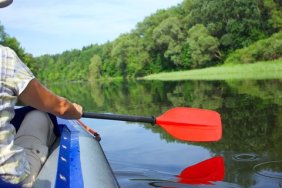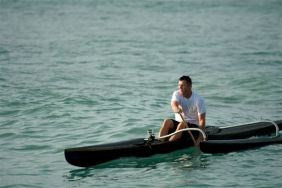 Kayaking isn’t a difficult activity to learn. With a little practice, anyone can become adept at maneuvering a kayak across lakes and calm rivers. But what about rapids? Rapids may be intimidating for newcomers, but today we’ll take a look at some helpful tips for when you come up against a bit of whitewater.
Kayaking isn’t a difficult activity to learn. With a little practice, anyone can become adept at maneuvering a kayak across lakes and calm rivers. But what about rapids? Rapids may be intimidating for newcomers, but today we’ll take a look at some helpful tips for when you come up against a bit of whitewater.
To better handle rapids on the river, one key factor will be learning to let your upper and lower body work independently of, yet cooperatively with, each other. To do this properly, maintain a distinct separation of movements at your hips. Mastering this concept starts with leaning forward and backward in your kayak. As you progress, though, it will become the key ingredient to balancing your kayak on edge and staying ahead of your boat as it spins in rougher waters.
To make the most of each paddle stroke, you’ll need to use more than just your arms and shoulders; you’ll need to use your torso. Using the larger muscles in your torso will further strengthen each stroke of the paddle, and will improve your stamina by spreading the work over more muscles. There are three components to using your torso to propel a kayak: winding your body, planting a pivot point with your paddle, and unwinding your body—all of which are collectively known as torso rotation. To wind up, turn your upper body at the hips in the direction you want to go, with your stomach and chest no longer facing the direction that your kayak does. Then, plant your paddle blade completely in the water as a pivot point. As you push or pull on this pivot blade, draw on your stomach muscles to force your body back to its original position. By rotating your torso, you can reach as far back as you want with a paddle and still be in a safe position, which helps protect your shoulders from strain or injury.
Keeping an active paddle blade in the water will go a long way towards keeping your kayak under control, which means it’s important to get your next paddle stroke into the water as soon as the one you’re taking is finished. By keeping your paddle in the water, you play an active role in deciding what your kayak will do, rather than reacting to the things that happen to it.
Practicing the techniques outlined above will help you carve through rapids in your kayak before you know it. There’s nothing wrong with calm lakes and rivers, but every now and then, a little change of pace and scenery is in order. If you’ve been itching for a challenge with your kayak, then keep these tips in mind to safely handle yourself in whitewater situations.








